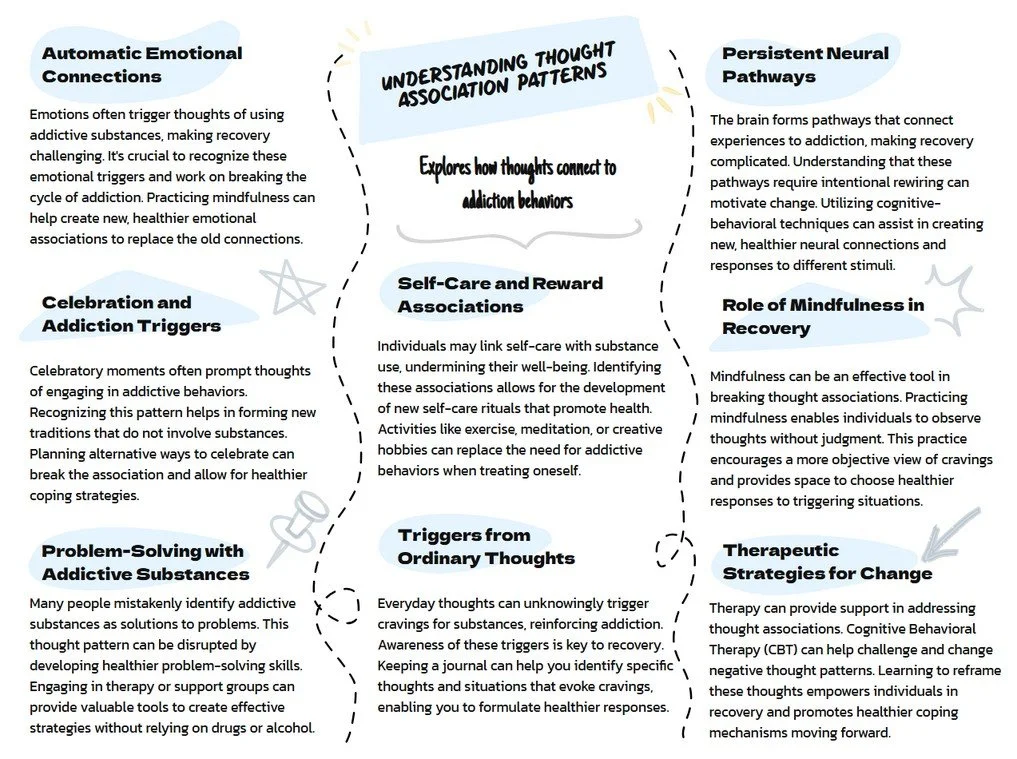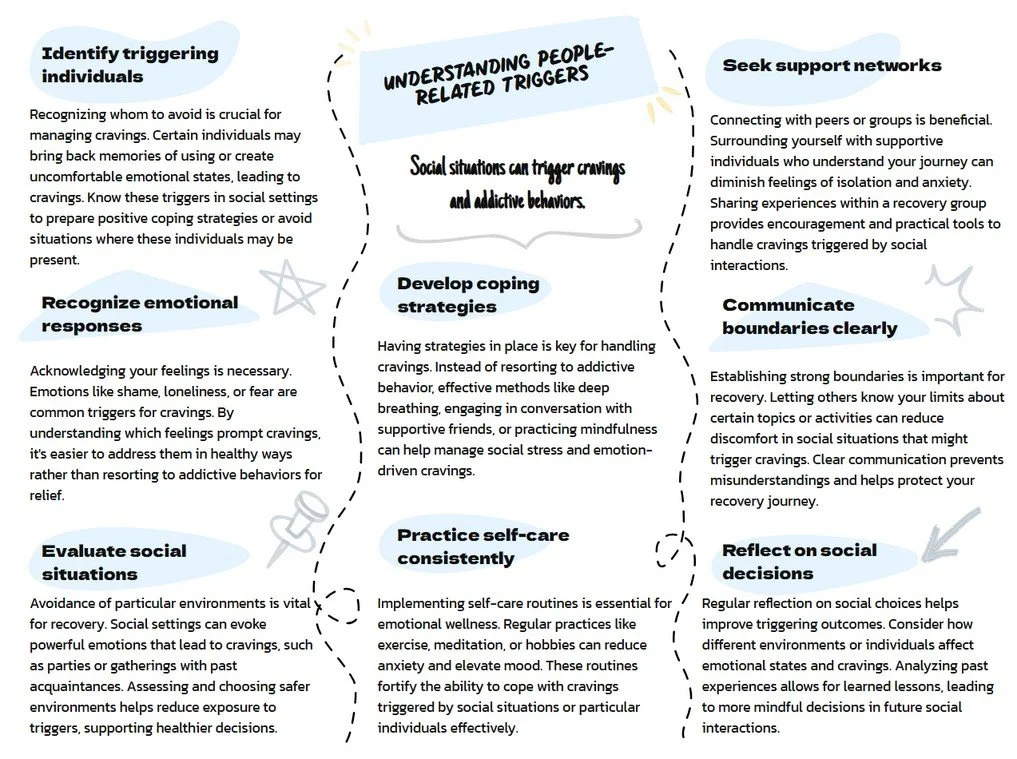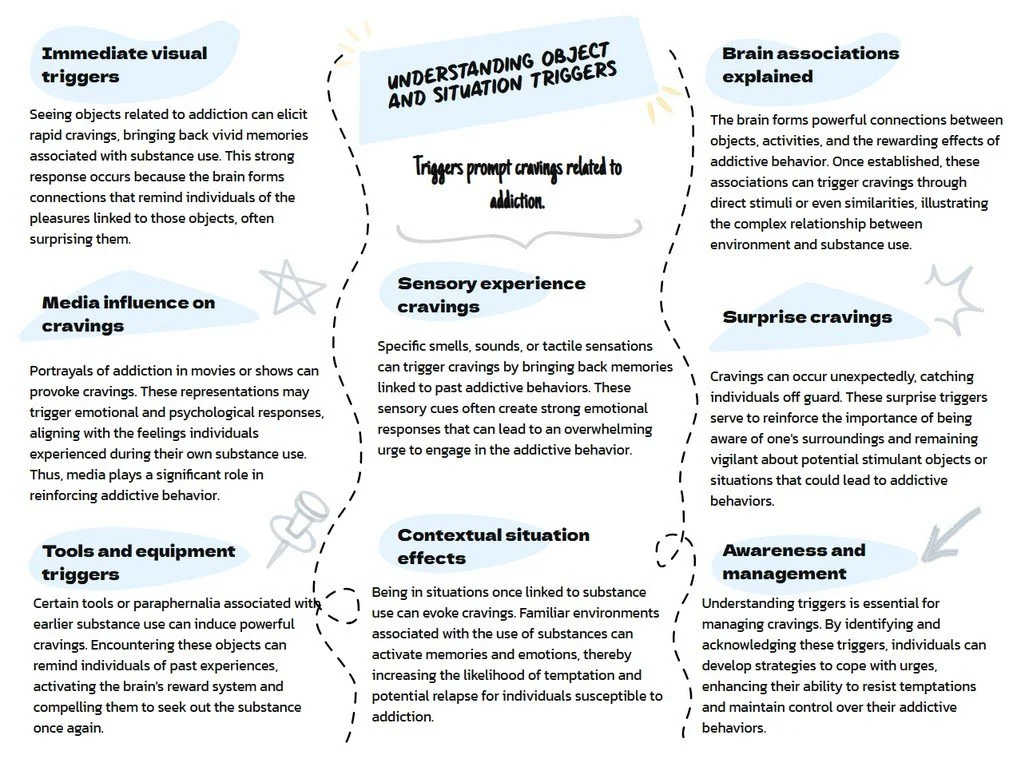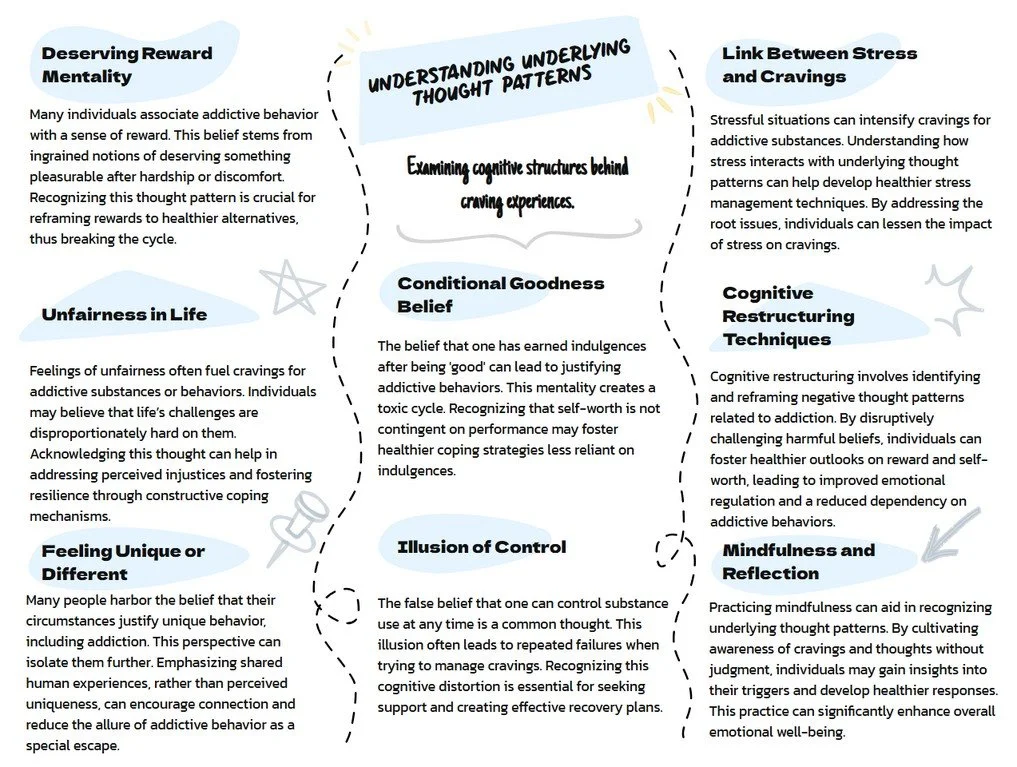
Recognizing Craving Patterns
Cravings are not simply "wanting" something—they involve a sophisticated neurobiological response that can manifest across multiple dimensions simultaneously. A craving might begin with a physical sensation, trigger a cascade of thoughts and memories, intensify through environmental cues, and create compelling mental narratives that challenge your recovery commitment. Understanding these multifaceted patterns is essential for developing effective management strategies.
This assessment explores seven key dimensions of craving experiences: physical sensations, mental obsession, thought association patterns, people-related triggers, place-related triggers, object/situation triggers, and underlying thought patterns. By mapping your unique craving landscape, you can develop personalized strategies that address your specific vulnerability patterns rather than relying on generic approaches.
This comprehensive self-assessment is designed to help individuals identify, understand, and develop effective responses to cravings—one of the most persistent and challenging aspects of recovery. Cravings represent the complex interplay between physical, psychological, environmental, and cognitive factors that can threaten recovery stability and create intense internal pressure to return to addictive behaviors.
Understanding Different Craving Dimensions
Physical Cravings
Physical cravings represent the body's neurobiological response to the absence of addictive substances or behaviors. These cravings can manifest as specific physical sensations, phantom experiences of past use, or general physical discomfort that seems to call for relief through addictive behavior.
Common manifestations include:
Specific physical sensations (tension, restlessness, empty feeling, agitation)
Phantom sensations that "remember" the effects of addictive substances
Changes in appetite, sleep, or energy that correlate with craving intensity
Physical symptoms during intense cravings (sweating, racing heart, muscle tension)
Body responding to triggers before conscious awareness
Understanding physical cravings: The brain's reward system creates powerful physical memories associated with addictive behaviors. These memories can be triggered by stress, specific physical states, or even random neurochemical fluctuations. Physical cravings often feel urgent and compelling because they tap into basic survival mechanisms.
Mental Obsession
Mental obsession involves persistent, intrusive thoughts about addictive substances or behaviors that feel difficult to control or dismiss. These thoughts can become so consuming that they interfere with daily functioning and create intense internal pressure to use.
Common manifestations include:
Persistent thoughts about using even when you don't want to think about it
Elaborate mental fantasies or scenarios about returning to addictive behavior
Mental negotiations about the possibility of controlled use
Intrusive thoughts that feel more compelling than thoughts about recovery
Mental loops where the same thoughts replay repeatedly
Understanding mental obsession: The brain's pattern-recognition system creates strong neural pathways associated with addictive behaviors. These pathways can be activated by various triggers, creating automatic thought patterns that feel involuntary. Mental obsession often intensifies when resisted directly, requiring sophisticated management strategies.
Thought Association Patterns
Thought association patterns involve automatic mental connections between ordinary thoughts or experiences and addictive substances or behaviors. These associations can make it difficult to think about common experiences without them connecting to using.
Common manifestations include:
Automatic connections between emotions and thoughts of using
Celebration thoughts that immediately include addictive behavior
Problem-solving thoughts that include addictive substances as solutions
Thoughts about self-care or reward that automatically connect to addictive behavior
Ordinary thoughts that trigger mental images of using
Understanding thought association patterns: The brain creates efficient neural pathways that connect related experiences. When addictive behaviors become central to life, they become associated with many different experiences and emotions. These associations can persist long after the behavior stops, requiring intentional rewiring.
People-Related Triggers
People-related triggers involve cravings that arise in connection with specific individuals or social situations. These triggers can be activated by being around people who use, people from your using past, or social situations that create uncomfortable emotions.
Common manifestations include:
Cravings when around people who are currently using
Cravings triggered by specific people even when they're not using
Social anxiety or discomfort that triggers cravings for relief
Feeling different from others in ways that trigger cravings
Conflict or tension with specific people that reliably triggers cravings
Understanding people-related triggers: Humans are social beings, and many addictive behaviors become deeply intertwined with social connections and situations. People-related triggers often involve complex emotions like shame, fear, loneliness, or social anxiety that were previously managed through addictive behavior.
Place-Related Triggers
Place-related triggers involve cravings that arise in specific locations or types of environments. These triggers can be activated by places where you used to engage in addictive behavior or environments that create specific emotional states.
Common manifestations include:
Intense cravings in locations where you used to use
Cravings in environments where substances/behaviors are readily available
Cravings in places associated with celebration, relaxation, or stress
Cravings when feeling anonymous or when accountability is low
Cravings in places that hold strong emotional memories
Understanding place-related triggers: Environmental cues become strongly associated with addictive behaviors through repeated pairing. The brain creates powerful location-based memories that can be triggered by returning to specific places or even similar environments. These triggers often involve multiple sensory cues working together.
Object/Situation Triggers (Things)
Object and situation triggers involve cravings activated by specific items, activities, or circumstances associated with addictive behavior. These triggers can be immediate and powerful, often catching people off guard.
Common manifestations include:
Immediate cravings when seeing objects associated with addictive behavior
Cravings triggered by media portrayals of addictive substances/behaviors
Cravings when encountering tools or equipment associated with using
Cravings triggered by specific smells, sounds, or sensory experiences
Cravings when encountering situations that used to be "enhanced" by addictive behavior
Understanding object/situation triggers: The brain creates strong associations between specific objects, activities, and the rewarding effects of addictive behavior. These associations can be triggered by direct exposure or even similar objects/situations, creating immediate craving responses.
Underlying Thought Patterns
Underlying thought patterns involve the deeper cognitive structures that support craving experiences. These patterns often reflect core beliefs about deserving, fairness, control, and the role of addictive behavior in life.
Common manifestations include:
Thoughts about deserving reward or relief through addictive behavior
Thoughts about how unfair life is without addictive behavior
Thoughts about being different from others or special cases
Thoughts about having been "good" long enough to deserve a break
Thoughts about being able to control use "this time"
Understanding underlying thought patterns: These patterns often reflect deeper beliefs about self-worth, control, pleasure, and coping that were developed over time. They provide the cognitive foundation that makes other craving experiences feel justified or compelling.







